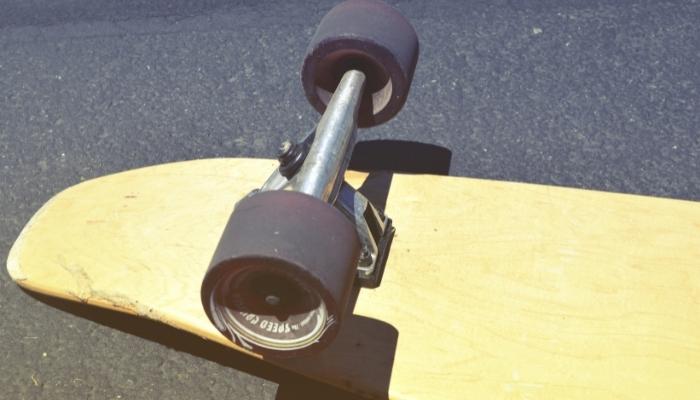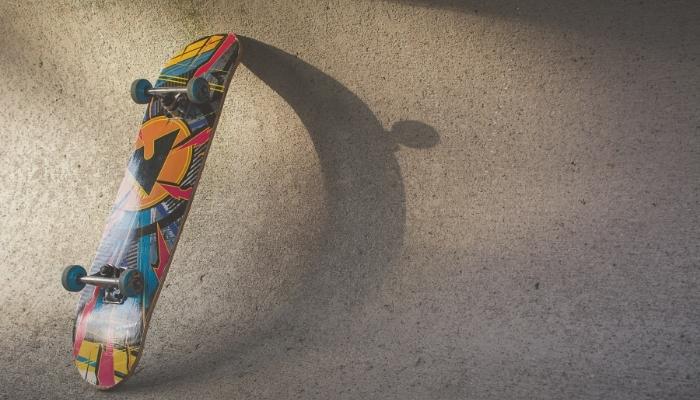How Much Does A Skateboard Deck Weigh? | Which Factors That Influencing |
Last Updated on July 11, 2024 by BoardsRiding

How much does a skateboard deck weigh? The average weight of a skateboard deck is between 2 to 5 pounds without trucks, bearings, wheels, grip tape, or you standing on it. The deck is normally made up of 7 layers of wood laminated together. Fewer layers of wood reduce the board’s weight. The deck is typically 7.25–8.5 inches broad and between 29′′ and 33′′ long.
Skateboard weights with trucks, wheels, & bearings range between 7 and 10 pounds. The most crucial choice is deciding on a deck. It has a significant impact on the overall feel of a skateboard’s weight limit, riding styles, & the basis for other components like skate trucks, bearings, & wheels. Over time, companies modified their products to use stronger, lighter materials for optimal performance for skateboarders.
How Much Does A Skateboard Deck Weigh?
Skateboards are sports equipment that is used for transportation & enjoyment. Skateboards are made up of three parts: the deck, the trucks, and the wheels. When it comes to diverse riding styles, the skateboard deck is really important. As if you’re a professional rider who enjoys doing stunts in front of people, you will select the lightest deck.
Furthermore, you may simply turn your board while performing ollies or other tricks. Fibreglass, aramid, Kevlar, and carbon fiber are among the possible reinforcements. Now, let’s go into the specifics of how much does a skateboard deck weight, as well as other skate parts. The weight of a skateboard is an important component to consider for all skateboarders in order to attain optimal performance and experience a long-lasting pleasure.

There’re various distinct varieties of professional boards on the market now, each with its own weight and structure. Fortunately, skateboard decks exist in a range of forms and sizes, so each rider’s weight requirement will be considered when purchasing. Skate decks are the basis for safe and smooth riding. Significant progress has been achieved in decks that are stronger, more durable, and lighter. Deck construction that provides enhanced rigidity and strength for light weight while keeping deck costs as low as feasible.
Don’t forget to also check our guides to the best cameras for skateboarding & best skateboard backpack for all time.
Does The Skateboard Deck Weight Matter?
Skateboards are sporting equipment used for transportation and recreation. Skateboard weight matters in the following situations:
A Lighter Deck Allows You To Do Tricks Better:
On lighter boards, learning flip techniques is simpler. This is due to heavier skaters getting greater momentum and finding it more difficult to regulate their movement. Skateboards with a lower weight often have a smooth ride, making them excellent for sliding. A lightweight full-size board having a width of 7.5 to 7.75 inches flips quicker than its heavier, broader siblings.
Skateboards made of lightweight materials enable you to do tricks with ease. It’s, however, more crucial to choose a deck size that you are comfortable riding on. Big feet will struggle to manoeuvre on a too-small board.
Bringing A Skateboard On A Plane:
When it comes to carrying a skateboard on an aeroplane, the deck’s weight is important. Nonetheless, there’re some restrictions on the size and total weight of the skateboard. However, you may bring the skateboard in your carry-on baggage and store it in the overhead compartment of most airlines. Before purchasing a ticket, it’s best to double-check the size as well as weight limits.
There will be no unpleasant shocks while passing security if you know the rules and follow them. If you bring your skateboard as a carry-on, its length should not exceed 62 inches, as well as the total weight of all skateboard parts (wheels, bearings, trucks) should not exceed 50 pounds.
If you’re fresh to skating, begin with a lighter deck & progress as you gain confidence.
Comparison Table Chart Of Skateboard Deck Weights:
Here’s the comparison table:
| Header | Width | Shoe size | Average Weight Capacity | Skater’s Age |
| Micro | 6.5 – 6.75 inches | Size 3 or under | 45 pounds | 5 years old and under |
| Mini | 7 inches | Size 4 – 6 | 59 pounds or under | 6 – 8 years old |
| Mid-Size | 7.3 inches | Size 7 – 8 | 63 – 89 pounds | 9 – 12 years old |
| Full Size | 7.5 inches and beyond | Size 9 and up | 195 pounds | Over 13 years old |
Which Factors That Influencing The Skateboard Deck Weigh:
The skateboard deck weight differs and is a key element to consider when selecting the ideal board for you.
Deck Type:
The weight of skateboard deck will be affected by the sort of deck you select. Longboards are often heavier than shorter boards; therefore, if you want something light, choose a cruiser or street board.
Deck Material:
Decks are made from a variety of materials, ranging from plastic to wood as well as everything in between, depending on the manufacturer. The most commonly used material is maple, a light, and solid wood. Maple wood’s fibre-rich nature makes it among the heaviest materials for skate decks. However, the heavyweight comes with the added benefit of maple boards being extremely robust and solid.
A maple board commonly contains seven to nine wood layers with a polyurethane covering due to the material’s increased strength, and if well constructed, it can sustain up to 220 pounds. Carbon fiber produces stronger, higher-quality boards, such as Revolution Enterprises’ Revdeck. This substance is much lighter than maple wood. Bamboo is another popular choice among green skaters.
Bamboo boards are nearly hollow and airy, with no wood fibres, making them lighter than maple boards. A bamboo skateboard is an excellent option for environmentally conscious skateboarders. Bamboo is thinner and less woody than maple; therefore, bamboo boards are more flexible but less sturdy. These characteristics make them better suited to navigating uneven terrain and making quick bends.
Penny boards are commonly moulded using vinyl plastic. These plastic boards are also lighter. Vinyl plastic skateboards, on the other hand, are less durable & hold a lower weight than bamboo skateboards. They’re more suited for commuting than stunts.
Deck Shape:

In general, three skateboard designs have been produced to meet various riding needs.
Your Weight As A Factor /Does My Own Weight Have An Impact On My Performance?
A strong skateboard can support up to 250 pounds (115 kg). Rider weight has an impact on how well a skateboard performs and how effectively you do specific tricks. It may be harder to acquire air when executing tricks like ollies&kickflips if you are heavier. Riders that are lighter will be able to go faster and might be able to perform stunts that demand more forceful movements.
Going downhill, a heavier skater might have more momentum. Lightweight skateboarders will accelerate faster; however, they will not have as much momentum as a heavy skateboarder while going down ramps.
Is It True That Cheaper Skateboards Are Heavier?
You may be wondering if less expensive boards are heavier than professional boards. Weight comparisons are relative, while quality is not. Professional setups are more secure, dependable, and use high-quality materials. It’s far more difficult to master tricks and sustain essential speed.
Which Is Better: A Heavy Or Light Skateboard?
When making a selection, it’s critical to take into account the weight as well as the width of your skateboard. A heavier board will be more stable, but it may be more difficult to manoeuvre. Skateboards vary in a variety of widths, so select one that suits you well. Your stance, leaps, and tricks should match the roughness or smoothness of the terrain; a heavier board will give better stability for certain manoeuvres.
Finally, ensure that your skateboard is tough enough for regular usage; heavier boards can withstand more punishment than lighter ones.
What Is Too Heavy For Skateboarding?
Skateboarding is a terrific way to get some exercise while still having fun, but be mindful of the weight you’re carrying. Skateboarding becomes more unsafe and harmful for people who weigh more than 220 pounds. Other manoeuvres are more vital than ollies and kickflips; if you’re new to skating, stay with those.
Experimenting with manoeuvres that are beyond your level of comfort may result in damage. Check the weight restriction before you begin so you don’t damage yourself or another person.
FAQs: How Much Does A Skateboard Deck Weigh:
Final Thoughts: How Much Does A Skateboard Deck Weigh:
The weight of a skate deck is determined by various elements, including material, size, grip tape, and other considerations. Make sure you choose the right board for your body type since an improper combination of board size & feet might hurt your performance.
All of the information about the weight of a skate deck has been thoroughly explained. There would be no more questions about how much does a skateboard deck weigh. Everyone is unique, so take the time to experiment and come up with a complete skate that you enjoy spending time on.
I’m Mike Dave & Focused on Riding Boards we are on a mission to grow the love for different types of board riding. We want to build interest by providing complete guides of boards so, if you want to increase your knowledge about riding boards, this website is a perfect selection for you, do hit a survey on this website and you will surely love it.






